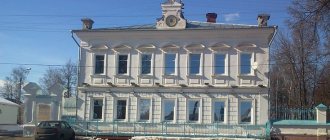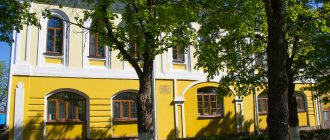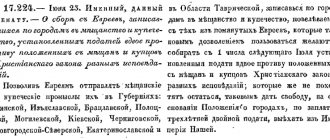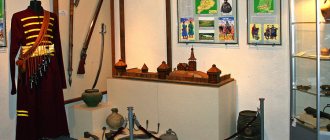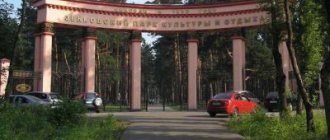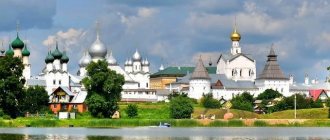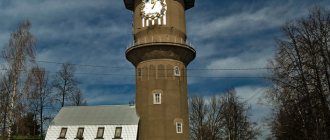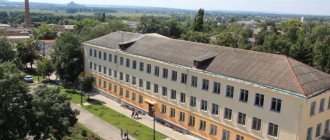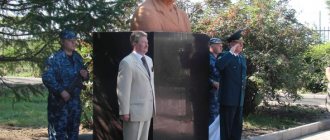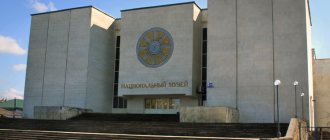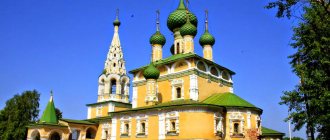Bogoroditsk is a city in Central Russia, the administrative center of the Tula region. Located on the right bank of the Upyorta River (a tributary of the Upa), 65 km southeast of Tula, 240 km south of Moscow. An ancient Russian city. In the center of the city is the Upyorta River, on the high bank of which there is the first landscape park in Russia, and in the park there is a palace-museum of the 18th century. The city has developed road services, as well as the production of clothes dryers and fumigators. Bogoroditsk is a small provincial town, divided from north to south by the Upertaya River, with a traditional radial-ring structure in its western part. Almost the entire eastern part of the city is occupied by the palace museum. The main city thoroughfare is Kommunarov Street.
Palace of Count Bobrinsky
The palace is located on the territory of the estate; it was erected on the initiative of Catherine II, as a gift to her illegitimate son, Count Alexei Bobrinsky. The palace is a luxurious two-story white stone building with a high base and a semicircular projection on the western part of the facade. At the entrance to the complex you can see the Entrance Tower, also known as the bell tower - this is the gate to the count's lands. Contains construction features characteristic of the Baroque style. The gate is decorated in the same spirit as other buildings in the complex.
Links[edit]
Sources [edit]
- ^ abcde Law No. 954-ZTO
- ^ ab Law No. 954-ZTO defines a city of regional subordination as a city that is part of one of the districts of the region. OKATO lists Bogorodsk as part of the Bogorodsky District and separately from other administrative divisions of the district.
- ^ a b c d Administrative-territorial structure of the union republics.
1987. , p. 242 - Official website of Bogoroditsk. Meeting of municipal deputies (in Russia)
- ^ a b Federal State Statistics Service (2011). All-Russian Population Census 2010. Volume 1 [All-Russian Population Census 2010, vol. 1]. All-Russian Population Census 2010 [All-Russian Population Census 2010] (in Russian). Federal State Statistics Service.
- "26. The size of the permanent population of the Russian Federation by municipalities as of January 1, 2022". Federal State Statistics Service. Retrieved January 23, 2022.
- State Committee of the Russian Federation on Statistics. Committee of the Russian Federation for Standardization, Metrology and Certification. No. OK 019-95 January 1, 1997 “All-Russian classifier of objects of administrative-territorial division. Code 70 208 501”, ed. changes No. 278 / 2015 dated January 1, 2016. (Goskomstat of the Russian Federation. Committee of the Russian Federation for Standardization, Metrology and Certification. No. OK 019-95 January 1, 1997. Russian classification of administrative divisions) (OKATO).
Code 70 208 501 , as amended by Amendment No. 278/2015 of January 1, 2016). - ^ abcd Law No. 555-ZTO
- Federal State Statistics Service. Federal Agency for Technological Regulation and Metrology. No. OK 033-2013 January 1, 2014 “All-Russian classifier of municipal territories. Code 70 608 101.” (Federal State Statistics Service. Federal Agency for Technological Regulation and Metrology. No. OK 033-2013 dated January 1, 2014. Russian classification of municipal territories. Code 70 608 101.
). - "On the Calculation of Time". Official Internet portal of legal information
. June 3, 2011. Retrieved January 19, 2022. - Post office. Information and computing center of OASU RPO. ( Post office
).
Search for postal service objects ( postal Search for objects
) (in Russian) - ↑
Federal State Statistics Service of Russia (May 21, 2004). The population of the Russian Federation, cities of the Russian Federation as part of federal districts, urban settlements, settlements, settlements, settlements is 3 thousand or more people. [Population of Russia, its federal districts , subjects of the Federation, districts, urban settlements, rural settlements - administrative centers and rural settlements with a population of more than 3000 people] (XLS). All-Russian Population Census of 2002 [All-Russian Population Census of 2002] (in Russian). - All-Union Population Census of 1989 Population of Union and Autonomous Republics, Autonomous Regions and Districts, Territories, Regions, Urban Settlements and Village District Centers [All-Union Population Census of 1989: Current Population of Union and Autonomous Republics, Autonomous Regions and Districts, Territories, Regions , districts, urban settlements and villages performing the functions of district administrative centers]. All-Union Population Census of 1989 [All-Union Population Census of 1989] (in Russian). Institute of Demography of the National Research University: Higher School of Economics [Institute of Demography of the National Research University: Higher School of Economics]. 1989 - via Demoscope Weekly
. - Natalya Suvorova; Vladislav Seregin; Valeria Zhitkova; Tatyana Odintsova (December 29, 2015). Sanctions to help: how to make money from import substitution (in Russian). RBC Information Systems. Retrieved October 26, 2016. CS1 maint: discouraged parameter (link)
Notes[edit]
- "THE USSR. Administrative-territorial division of the union republics. 1987." ( USSR. Administrative-territorial structure of the union republics. 1987
) / Compiled by V. A. Dudarev, N. A. Evseeva. - M.: Publishing house "Izvestia of the Soviets of People's Deputies of the USSR", 1987. - 673 p. - Tula Regional Duma. Law No. 954-ZTO of December 27, 2007 “On the administrative-territorial structure of the Tula region,” as amended. Law No. 2131-ZTO of June 11, 2014 “On Amendments to the Law of the Tula Region” On the Administrative-Territorial Structure of the Tula Region “. Came into force ten days after official publication. Published: “Bulletin of the Tula Regional Duma”, No. 11–12 (142–143), part 4, November – December 2007 (Tula Regional Duma. Law of December 27, 2007 No. 954-ZTO “ On the administrative-territorial structure ").
Tula region as amended by Law dated June 11, 2014 No. 2131-ZTO.
On amendments to the Law of the Tula Region “On the administrative-territorial structure of the Tula Region” and to the Law of the Tula Region “On establishing the boundaries of administrative-territorial units - districts in the city of Tula”
. Valid from the day that occurs ten days after the official date of publication.). - Tula Regional Duma. Law No. 555-ZTO of March 14, 2005 “On the renaming of the municipal formation” of the city of Bogoroditsk and the Bogoroditsky district “of the Tula region, establishing boundaries, conferring status and determining the administrative centers of municipalities in the territory of the Bogoroditsky district of the Tula region,” as amended. Law No. 1910-ZTO of April 1, 2013 “On the transformation of municipalities in the territory of the Bogoroditsky district of the Tula region and on amendments to the Law of the Tula region” On the renaming of the municipal formation “City of Bogoroditsk and Bogoroditsky district” of the Tula region, establishing boundaries, granting status and definitions of administrative centers of municipalities on the territory of Bogoroditsky Tula Tula region region "". Came into force ten days after official publication. Published: “Tula News”, No. 77–80, March 29, 2005 (Tula Regional Duma. Law of March 14, 2005 No. 555-ZTO “ On the renaming of the municipal formation “city of Bogoroditsk and Bogoroditsky district” of the Tula region, on the establishment borders, assignment of status and creation of administrative centers of the municipality").
Entities on the territory of the Bogoroditsky district of the Tula region as amended by Law No. 1910-ZTO of April 1, 2013 “
On the transformation of municipalities on the territory of the Bogoroditsky district of the Tula region and on amendments to the Law of the Tula region “On transformation”.
Renaming the municipal entity “city of Bogoroditsk and Bogoroditsky district” of the Tula region, on establishing boundaries, assigning status, and creating administrative centers of municipal entities on the territory of the Bogoroditsky district of the Tula region . Valid from the day that occurs ten days after official publication.).
Bogoroditsky Park
Bogoroditsky Park is considered an obligatory part of the estate of Count Bobrinsky. The park was formed by Andrei Timofeevich Bolotov in an almost empty and waterless space. According to his plan, a cascade of ponds was created and a park was laid out. About 250 people took part in the construction. In addition to all this, the agronomist was a writer, philosopher, and scientist.
Unfortunately, many of Bolotov’s creations were destroyed in the post-revolutionary period. Now there are no waterfalls here, but in their place there are many buildings. Almost all corners of the park are overgrown and have lost their former forms, the reservoirs have become shallow and overgrown. Work on the reconstruction of the park began only at the beginning of 1970, despite this, it was possible to restore the seductiveness of the park and its unobtrusive beauty. In spring, the estate is reflected in the water surface of a huge pond, attracting the eyes of people passing along the embankment. In 1989, a monument to its developer was erected in the park.
Manor in modern times.
Now the Bobrinsky estate is the hallmark of the city. There is a museum in the main manor house, and everyone can take a walk in the park. The entire complex of manor buildings in Bogoroditsk can be conditionally divided into two parts: “ceremonial” buildings located on one bank of the dammed Uperta River and buildings located behind its dam and on the other bank.
"U Gashi" - home theater
Theater "U Gashi" is a home theater in Bogoroditsk. It started with the play “Carnival” based on the work of Lope de Vega, the premiere of which took place at the end of December 1987. The theater was authorized on the basis of the “Library of Arts”, which was located on the estate of Count Bobrinsky.
The theater owes its name and birth to Natalya Alekseevna Mashutina, the library manager, and Galina Anatolyevna Spesivtseva, the librarian. To brighten up the evenings, they began to stage plays and read poetry. All this took place in the library at the “Club of Lovers.” Spectators who attended this event began to call it: Home Theater “U Gashi”, after the names of the founders GALINA and NatASHI.
"Tula Peterhof".
The city of Bogoroditsk is often called the “Peterhof of Tula”. It received this name not at all due to its proximity to the Northern capital and access to the sea. The small town of the Tula region earned its loud unofficial name thanks to the unique palace and park complex of the Bobrinskys, which to this day delights the eyes of visitors.
St. Kazan Church
According to written sources that have survived to this day, a long time ago in the town of Bogoroditskoye there was a church built of wood; it was consecrated under the appeal of Elijah the Prophet. This small temple, like all wooden structures, was destroyed by fire. In 1774, an order was received from the royal court to build a stone church of the Kazan Icon of the Mother of God, the plan of which was invented by the young master I.E. Starov. – graduate of the Russian Art Academy.
On the south side of the Kazan Church according to the plan of the Tula designer K.S. Sokolnikov in 1784 a building was built for an ethnic school for 2 classes. It taught writing, literacy, vocals, music playing, mathematics, and some specialties so that students had the opportunity to work. Later this premises was designated as residential, then as a dormitory building for a children's camp. In 1969, the first art book depository was opened, and in 1971 a youth children's gymnasium began operating.
Location: park named after A.T. Bolotova.
Apple orchards and thyme field
To the side of the estate there is another example of the revitalization of the area. It was once part of the palace complex, but during the Soviet years it was converted into a collective farm with apple orchards, and after the collapse of the USSR they stopped caring for the place. As you understand, over the years the gardens have become a forest:
Now the site has new owners, and architects and other specialists are working on it. The first thing they did here was sanitary felling of maple trees. The bizarre shapes of apple trees became visible, reaching towards the sun through other trees.
When they began to study apple trees, it turned out that some were already more than 80 years old. Many different varieties have been preserved here: from traditional to the rarest. They are trying to rejuvenate the trees: they feed them and prune them. Each tree is given a number to know exactly what variety it is and to track and treat diseases.
Two fields have also been set up here: for new apple trees and thyme.
photo bureau "Novaya Zemlya"
Thyme is a symbol of the Virgin Mary. Nine bunches of thyme are depicted on the city's coat of arms. They plan to create hills in the fields and plant different varieties of thyme on them. The entire field is surrounded by the trees of the old park, which provides wind protection and a beautiful backdrop.
The new owners have very ambitious plans for cider brewing and eco-tourism, but that will all come later. In the video, Irina Glik talked about this in detail.
Cathedral of the Assumption of the Blessed Virgin Mary
The cathedral was erected in the mid-19th century with the money of the Mother of God merchants. It has a look corresponding to the Empire style. Many years later, another temple of St. George the Victorious is discovered in the bell tower. Currently, the cathedral offers video rental of Christian films.
Location: 10th Army Street - 13.
First children's theater
At the end of the 18th century, the first children's theater was opened in Bogoroditsk on the count's estate. The play, based on the script by M. M. Kheraskov, “The Atheist” was staged in the fall of 1779 in one of the premises of the Bogoroditsky Palace. The roles were performed by local children who lived on the estate. At that time, the theater already had its own orchestra. Subsequently, the theater was given its own hall with a stage and seats for spectators. During the summer holidays, performances staged in the children's theater could attract more than 250 spectators.
Bogoroditsk History.
Founded in 1663 as a fortress on the southern borders of the Moscow state. After the construction of the temple in the name of the Intercession of the Most Holy Theotokos, it became the village of Bogoroditskoye. In the 17th-18th centuries. A busy trade route passed through Bogoroditsk, horses for transportation were supplied by the city stud farm, inns and taverns appeared. Since 1719, Bogoroditsk has been in the Tula province of the Moscow province. In 1763 it was transformed into the village of Bogoroditskoye, and from 1768 - a settlement. Since 1777, the district town of Bogoroditsk, Tula governorate (since 1796 - Tula province). In 1797-1802. - a city with no residents. During the Great Patriotic War, the city was occupied by Nazi troops on November 15, 1941. It was liberated on December 15, 1941 by troops of the Western Front during the Tula operation.
Bathhouse of the Bobrinsky sugar factory
Not far from the dam, near the pond, there is a red house. This is an old two-story building that formerly belonged to the sugar factory of Count Bobrinsky. On the first floor there was a bathhouse and a laundry room; the manager of the bathhouse lived on the second floor. After the factory closed in the 19th century, the building was converted into a residential building. At the beginning of the 20th century, the residents were resettled and since that time no one else has lived in the house.
The house is shrouded in legends and myths. Local residents say that people die in it and therefore try to avoid it. Now the house is in disrepair, but lovers of mysticism and the past are frequent guests there. After all, a journey into the past and revealing the secrets of the red house will not leave anyone indifferent.
Bogoroditsk. How to get there.
By train to the Zhdanka station of the Tula branch of the Moscow Railway. Or go to Uzlovaya station, and then take a regular bus. By car from Moscow by car along the M4 Don federal highway (extension of Kashirskoye Highway) to Voronezh up to 240 km. By bus there is a bus station in the city. Bus routes from Moscow, Tula, Novomoskovsk. Transits from Voronezh, Kurkino. Flights from Moscow depart from Krasnogvardeyskaya metro station every two hours. Travel time from Moscow is 3 hours, travel time from Tula is 1 hour.
There are regular buses and minibuses running in the city, but due to the large traffic intervals, you should only wait for them if the walking is really difficult. All objects of interest to a traveler are within walking distance. There are many taxi drivers, they arrive quickly, but they can inflate prices. Taxi numbers: +7 (48761) 2-20-00, +7 (48761) 2-14-14, +7 (48761) 2-15-15. The cost of the trip is from 100 rubles. During the summer navigation period, you can take a boat trip along Upörta, admiring the views of the palace and park.
